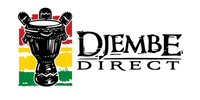|
How Do I Get Started?
In order to have an effective African drum component in your music program, you will need a variety of instruments and a group facilitator:
The Instruments
- Sizing: We get a lot of phone calls from teachers wondering which size djembe would work best for their students. First, BIGGER IS NOT ALWAYS BETTER! The drum needs to fit the drummer. Generally our guideline is ages 3-6 = Mini djembe (7-8" head), grades 1 to 6 = Small djembe (9" head), grades 6 to 9 = Medium djembe (10.5-11" head), and high school a variety of Medium, Large (12" head) and Extra Large (13.5" head) djembes, depending on the size of the student playing the drum and portability/storage needs. A medium djembe will give you the full sound and volume range you'll need in an educational setting, but may seem small for taller students or students with larger hands. A "standard" size djembe is 12-13" head x 23-24" tall.
- Building the Percussion Ensemble: You don't need a drum for each student. West African percussion ensembles always have bells, shakers, singers, hand clappers, and so forth. Stretch your budget by making use of our African classroom percussion instruments. A proper West African djembe ensemble consists of a set of dunun, 2 to 8+ djembes, 3 to 6 bells, 1 to 3 shekeres, a chromatic instrument such as a balaphone or kalimba, and singers and dancers.
- Discount Classroom Drum Packages: We have developed some package specials specifically designed to equip teachers and youth workers with the instruments they need to have a successful world percussion program. Please click the link to learn more!
Leading the Group
- You Can Do This! Many teachers want to incorporate African drumming into their curriculum or cultural units, but feel intimidated by not being a "drummer" or not having any facilitation experience. Our answer to this is, you don't have to be an expert djembe technician to give students the opportunity to discover the joys of African percussion. Take advantage of the resources professional drum circle facilitators have created for use by teachers and music therapists.
- Helpful Resources: To help you developing some basic djembe technique, we have some free tutorials available on our website, and encourage you to take advantage of local classes if they're available in your area, and to search the web for instructional videos. There are many books and DVDs available to teach you how to facilitate drum circles. Contact us for a recommended list!
Funding
- Start Small: We have spoken with teachers who feel they have to have the entire ensemble all at once in order to start an African community drumming unit in their classrooms. The fact is, most of the teachers we know who have been successful at creating programs have started small, with 1 or 2 djembes and maybe a shaker, often self-financed, and have built the instrument collection slowly. We have been told that as teachers can show that they already have something going and want to add to an existing program, it is much easier to get funding. And, large amounts of money don't often become available for this kind of thing, but smaller grants and other funding sources are much easier to come by, which can be used here and there to build the program.
- Be Thorough: Many teachers who have been determined to build an African drum program have had to discover less well known sources, such as grant programs on the internet, or in their local communities. At-risk youth and socially dysfunctional students are often those who are most blessed by African drum programs, as shown by verifiable studies (see links above), which helps widen the funding base for your program. Unfortunately we cannot publish a list here of all available non-traditional sources, but teachers have told us that somehow the money can be found by the teachers who are convinced of the benefits of African drumming for their students.
- Yes to Purchase Orders: Irie Tones wants to make it as easy for you to start or grow you African drum program, so we welcome purchase orders from verifiable organizations in the USA, as well as offer a substantial discount for drums shipped to commercial addresses where there is a verifiable youth program in action (public or private school, youth club, etc.).
- Get 15% Off! When you place an order that will be shipped to a commercial address where a verifiable youth program is currently operating, you can use the Promotional Code "SCHOOL", and a 15% discount will automatically be applied to your order. This offer is not available on package specials, and does not apply to shipping costs. Only one Promotional Code can be used for each individual order.
|







 10% Off Everything + Free Shipping! [Promo code LOVEMY10]
10% Off Everything + Free Shipping! [Promo code LOVEMY10]